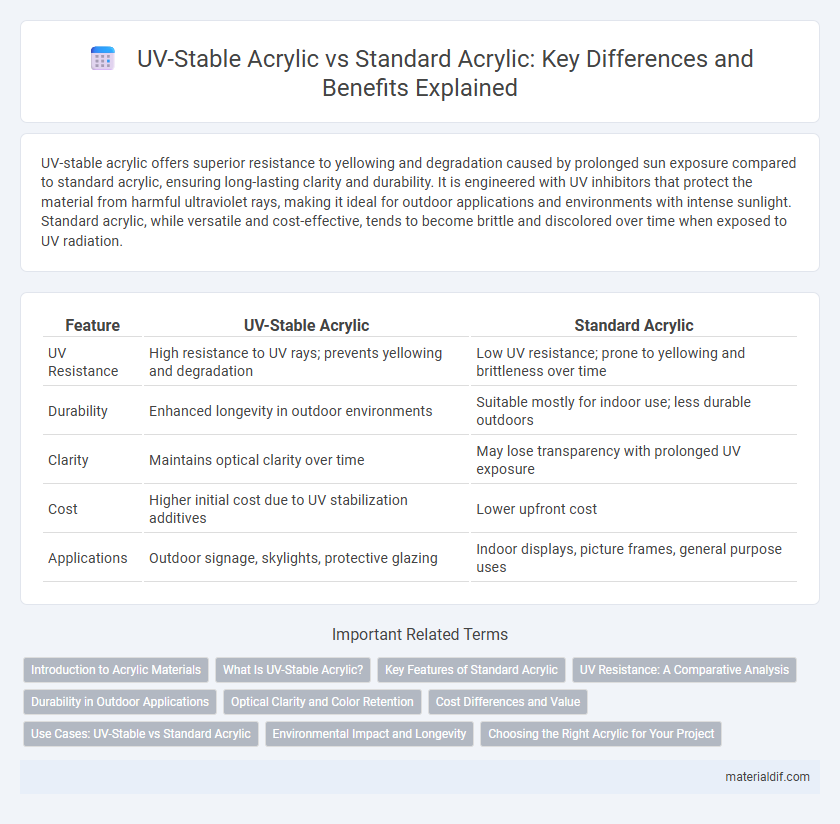UV-stable acrylic offers superior resistance to yellowing and degradation caused by prolonged sun exposure compared to standard acrylic, ensuring long-lasting clarity and durability. It is engineered with UV inhibitors that protect the material from harmful ultraviolet rays, making it ideal for outdoor applications and environments with intense sunlight. Standard acrylic, while versatile and cost-effective, tends to become brittle and discolored over time when exposed to UV radiation.
Table of Comparison
| Feature | UV-Stable Acrylic | Standard Acrylic |
|---|---|---|
| UV Resistance | High resistance to UV rays; prevents yellowing and degradation | Low UV resistance; prone to yellowing and brittleness over time |
| Durability | Enhanced longevity in outdoor environments | Suitable mostly for indoor use; less durable outdoors |
| Clarity | Maintains optical clarity over time | May lose transparency with prolonged UV exposure |
| Cost | Higher initial cost due to UV stabilization additives | Lower upfront cost |
| Applications | Outdoor signage, skylights, protective glazing | Indoor displays, picture frames, general purpose uses |
Introduction to Acrylic Materials
UV-stable acrylic features enhanced resistance to ultraviolet light, preventing yellowing and degradation compared to standard acrylic, which is more susceptible to UV damage. This makes UV-stable acrylic ideal for outdoor applications where prolonged sun exposure occurs. Standard acrylic remains a cost-effective option for indoor uses, offering clarity and durability without specialized UV protection.
What Is UV-Stable Acrylic?
UV-stable acrylic is a specially formulated material designed to resist degradation and yellowing caused by prolonged exposure to ultraviolet (UV) light. Unlike standard acrylic, UV-stable acrylic contains additives that block or absorb UV radiation, enhancing its durability and maintaining transparency over time. This makes UV-stable acrylic ideal for outdoor applications such as signage, glazing, and protective barriers where long-term clarity and structural integrity are essential.
Key Features of Standard Acrylic
Standard acrylic offers excellent clarity and high impact resistance, making it a versatile material for various applications. It typically features good weather resistance but lacks the enhanced UV stabilization of UV-stable acrylic, causing it to yellow or degrade over time when exposed to prolonged sunlight. Standard acrylic is cost-effective and easy to fabricate, suitable for indoor use or short-term outdoor projects without intense UV exposure.
UV Resistance: A Comparative Analysis
UV-stable acrylic incorporates special additives that significantly enhance its resistance to ultraviolet radiation, preventing yellowing and degradation over time. Standard acrylic lacks these UV inhibitors, making it more susceptible to discoloration, brittleness, and structural weakening when exposed to prolonged sunlight. Comparative studies reveal UV-stable acrylic maintains clarity and durability up to 10 times longer than standard acrylic under similar UV exposure conditions.
Durability in Outdoor Applications
UV-stable acrylic is specifically formulated with additives that protect against yellowing and degradation caused by prolonged exposure to ultraviolet light, significantly enhancing its durability in outdoor applications. Standard acrylic lacks these protective additives, making it more susceptible to cracking, fading, and brittleness when exposed to sunlight over time. This increased UV resistance in UV-stable acrylic ensures longer-lasting clarity and structural integrity for outdoor signage, glazing, and architectural panels.
Optical Clarity and Color Retention
UV-stable acrylic offers superior optical clarity by resisting yellowing and hazing caused by prolonged sun exposure, maintaining its transparent quality much longer than standard acrylic. Its color retention properties ensure vibrant hues remain consistent without fading, making it ideal for outdoor applications where appearance durability is critical. Standard acrylic, while clear initially, tends to degrade faster under UV light, resulting in diminished clarity and noticeable color loss over time.
Cost Differences and Value
UV-stable acrylic commands a higher price than standard acrylic due to its enhanced resistance to yellowing and degradation from prolonged sun exposure, making it ideal for outdoor applications. While standard acrylic offers a lower upfront cost, its susceptibility to UV damage can lead to more frequent replacements and increased long-term expenses. Investing in UV-stable acrylic provides greater durability and cost-efficiency over time, balancing initial investment with sustained value.
Use Cases: UV-Stable vs Standard Acrylic
UV-stable acrylic is ideal for outdoor applications such as signage, skylights, and greenhouse panels due to its superior resistance to yellowing and degradation from prolonged sun exposure. Standard acrylic, while cost-effective, suits indoor uses like picture frames, display cases, and furniture where UV exposure is minimal. Choosing UV-stable acrylic enhances durability and clarity in environments with intense sunlight, extending the lifespan of the material compared to standard acrylic.
Environmental Impact and Longevity
UV-stable acrylic contains additives that significantly reduce degradation caused by ultraviolet light, enhancing its longevity compared to standard acrylic which tends to yellow and become brittle over time. This increased durability reduces the need for frequent replacements, lowering overall environmental impact through decreased material waste and manufacturing emissions. Standard acrylic's shorter lifespan contributes to higher carbon footprints due to more frequent disposal and production cycles.
Choosing the Right Acrylic for Your Project
UV-stable acrylic offers superior resistance to yellowing and degradation under prolonged sun exposure, making it ideal for outdoor applications and projects requiring long-term clarity. Standard acrylic is more cost-effective but may discolor or weaken when exposed to UV light, limiting its suitability for exterior use. Selecting the right acrylic depends on balancing budget constraints with the need for durability and optical clarity in the project's environment.
UV-Stable Acrylic vs Standard Acrylic Infographic

 materialdif.com
materialdif.com